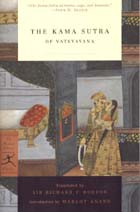
The Kama Sutra of Vatsyayana
Translated by Sir Richard F. Burton
Introduction by Margot Anand
Burton is probably most famous for his translation of "The Arabian Nights". His early interest in the world was fostered by his extensive travels throughout Europe in the early to mid- 1800s. He became talented in languages and fluent in the classical ones prior to college. He joined The East India Company and was long resident of Sind. He is also quite famous for dressing as an Afghani and traveled to Medina and Mecca, a great cause for worry as it is "haram" (forbidden) for a non-Muslim to venture into the holy sites of these cities.
So this translation is Victorian in presentation; something which many contemporary readers and writers might find a little too elegant a depiction of the content, to which there are several other more explicit translations with diagramatic accompaniments.
However, one must approach a written text with the the idea that an understanding of classical Indian erotica was quite available to the reading public of the late 1800's and was acceptable reading material. So perhaps the content is questionable only to the degree from which the translation might deviate from an exploratory and explanatory translation rather than interpretation.
In this regard, Burton contends with the erotic topics at hand with a great deal of civility and gracefulness.
However Margot Anand's introduction is contemporary, filled with current relativist perceptions on the extension of a centuries old original text and its universally applied validity. Anand does explain some of the circuitous routes by which the Kama Sutra has taken form and character for the considered "Rule Book" on lovemaking which goes far beyond Ovid's exhortations on the topic of sensuality and art of living and loving.
But I take some reserve in sharing her esteem for the vast lists of Indian and spiritual characters, as is my taste. I would not, for example, nor ever assume in fact, that the Guatama Buddha, Dali Lama, or Mother Theresa should be mentioned in the same breath as a charlatan like Osho or the likes of the Tantric Cults which abide by Oshoist practices.
Spirituality is a living act in itself; Buddhists and Christians, Muslims, and Jews, share many similar historically mysterious practices and meditations. I would not breath their faiths in the same realm as "Sky Dancers", or "Love and Ecstasy Trainers", etc. as Ananad does.
I am far too conservative and respectful of world religions for that.
While Anand doubtlessly has researched some of her beliefs, I must agree that India is a paradoxical place, and the manipulations of men or women by men or women or vice versa could at times be aided by some of the strategies described in this book.
But somehow that would appear less than purely spiritual.
The author or authors as it may be, of The Kama Sutra speak clearly at one point that this book is meant for husbands and wives, that the tales and lessons of this book are intended primarly for application to the maintenance of a loving union, and pointedly not for the abuse of such knowledge, not for the taking advantage of by men or women seeking to ruin the lives, marriages, or relationships of others.
It is from this perspective that the loving arts described could be fulfilled by most and would preclude the needs for services such as those which Anand provides. It is too easily assumed that there are others in the world who are capable of delivering or providing the skills and lessons necessary for the winning and keeping of a loving mate, for a loving union, and a loving life.
A reader should then embark on the tale of The Kama Sutra, especially if they would refuse to grant credence to any practioners of profit-making ventures which would seek to exploit their lack of enlightenment in such matters, and then try to teach them, not only what they already know intrinsically about their own loving and sexual capabilities, in the realms of ecstasy but their ability to reason with their own needs and characters.
Such "experts" would seek to interpret rather than explain or translate simply, as Burton has done, a work of classical art, from one language to another, in a form which does not offend the sensibilities or privacies of the curious reader.
So The Kama Sutra should be read simply. There is much of value within its pages. As there is in many other classic texts, such as The Illyad, The Oddessy, or even The Bible, The Koran, or The Baghavad Gita.
Burton's text is worth reading. But I would recommend selectivity when perusing Anand's introduction which should be classified as less than an elegant accompaniment to the path.

No comments:
Post a Comment